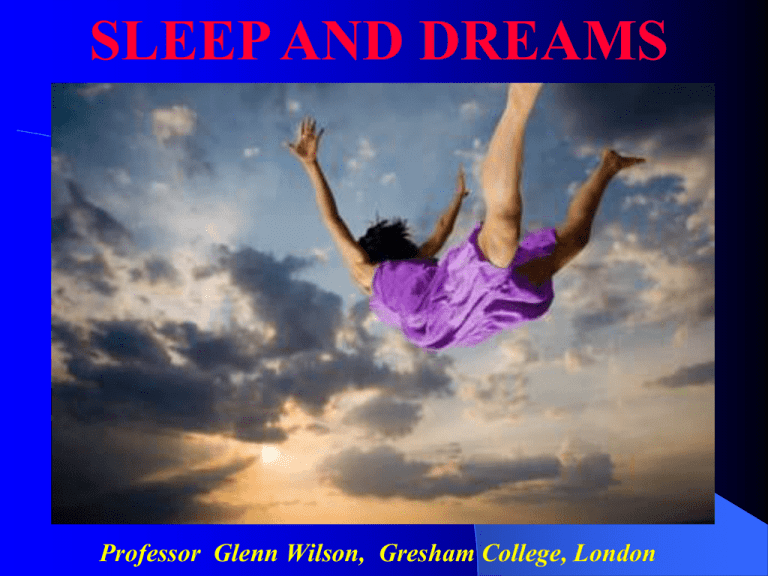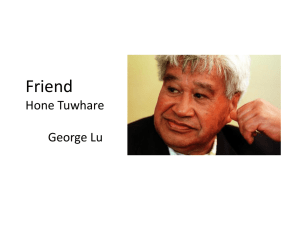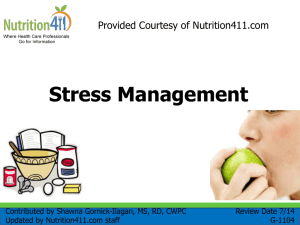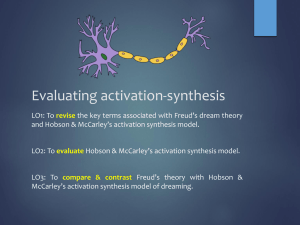
SLEEP AND DREAMS
Professor Glenn Wilson, Gresham College, London
STAGES OF SLEEP
Sleep has stages of increasing depth (difficulty in waking).
Deepest sleep (Stage 4) occurs after about 1hr. Rapid eye
movement (REM) sleep occurs in bursts that get longer
towards morning. This is when most dreams occur.
REM SLEEP IN CATS
REM sleep occurs in most
mammals, especially
predators like cats.
Probably dreaming
(rehearsing hunting
skills?). REM associated
with muscle relaxation.
Suggested that prey
animals cannot afford
much sleep.
“The lion and the lamb
shall lie down together but
the lamb won’t get much
sleep” (Woody Allen,
Love and Death).
SLEEP DEPRIVATION
As school science project (1965)
Randy Gardner stayed awake for
11 nights.
Became progressively
disorientated & impaired (blurred
vision, slurred speech,
moodiness, paranoia/delusions).
When finally allowed to sleep, he
slept 15hrs first night,10 on next
two (i.e., he lost 90hrs but made
up only 11).
Proportion of Stage 4 (68%) and
REM (53%) increased radically.
Suffered no obvious long-term
harm but rats deprived of sleep
die within a few weeks.
MEMORY STORAGE
Sleep important for
neurodevelopment, tissue
repair, immune function &
memory consolidation.
Material of future use is
selectively stored (Van
Dongen et al, 2012)
Sleep spindles (rapid EEG
oscillations in Stage 2) go
with relocation of memories
from hippocampus (shortterm storage) to prefrontal
cortex (“hard-drive”) thus
refreshing memory capacity
(Mander et al, 2011).
CIRCADIAN RHYTHM
Sleep cycle controlled by oscillators
in suprachiasmic nuclei of
hypothalamus (handy to light input).
Via a spinal detour, this modulates
secretion of melatonin from pineal
gland (more in darkness) which enters
bloodstream.
A second “clock” in the pons is
responsible for REM-sleep.
Jet lag, shift work, artificial light
interfere with diurnal cycle.
Northerly migration may also have
impact. Some think our ancestors had
two sleep phases in night separated
by hour or so of activity (esp. in
winter?).
SLEEPING PILLS
Approx. 12 million hypnotics
per yr prescribed in UK.
Most are addictable (including
barbiturates, benzodiazepines,
z-drugs and melatonin).
Interfere with restful sleep
(deep sleep/REMs), hence
fatigue & memory impairment.
Linked to cancer, Alzheimer’s
and higher mortality.
Minimal gains in sleep (15
mins faster, 37mins. longer);
half of it placebo (HuedoMedina, 2012).
COMBATTING INSOMNIA
Use bedroom only for sleeping &
sex (no eating, drinking, working).
Remove TV and computers (screens
emit light).
Ensure it is cool, quiet & dark.
Regular sleep/wake times.
Exercise in daytime (not late).
Avoid alcohol & stimulants like
caffeine before bed.
Don’t lie in bed fretting - better to
get up and do something.
8 hours not required by all (may be
less for older people).
If anxious or depressed, address the
problem (self-help or CBT).
SLEEP APNOEA
Interrupted breathing during sleep.
May be central (brain-based) or
obstructive (associated with
snoring). Sleeper not aware but
distressing to partner.
Leads to fatigue, daytime
sleepiness, moodiness, accident
proneness, immune depression.
Treatment may include avoidance
of alcohol & sleeping pills, weight
loss, oral devices that maintain
open airways and surgery.
Singing & playing musical
instruments (e.g., didgeridoo) may
help strengthen throat muscles.
NARCOLEPSY
Drowsiness/sudden sleep
attacks occurring at any time
(often inconveniently).
Associated with cataplexy –
sudden muscular weakness
brought on by strong
emotion.
Apparently intrusion of REM
sleep into daytime (includes
paralysis & dreams).
Heritable component but
occasionally linked with head
injury/neurological damage.
Treated by various drugs
(including stimulants and
SSRIs). Controlled daytime
naps may help.
IN YOUR DREAMS
Dreams are highly visual
(usually in colour).
Also emotional (esp. anxiety
& abandonment but also joy).
Often refer to events from
previous day or week.
Background stimuli
incorporated (e.g., doorbell,
music, water spray).
Surrealistic & morphing
(laws of physics don’t apply).
Symbolic and metaphorical.
Little sense of agency or
volition (things happen to us).
LUCID DREAMS
Dreamer aware they are
dreaming but allow it to
continue (c.f., psychotic
hallucinations; believed to
be real).
Lucid dreamers may have
control over the direction
of the narrative.
Some people able to learn
this capacity and harness it
for creativity or treatment
of distressing nightmares.
DREAMS OF DISABLED PEOPLE
Often dream as though they don’t have
the disability. Paraplegics walk, deafmutes talk and sing normally (Voss et
al, 2011).
Genetic programming or action of
mirror neurons (copying by
observation)?
People blind <5ys dream without visual
imagery (and little REM). Colour-blind
dream in colours they see.
Older people more likely to dream in
black & white (like media of their era).
NOCTURNAL INSPIRATION
Because associations are loose, dreams
may promote creative problem-solving.
Examples:
1. Benzene ring inspired by dream of a
snake biting its tail (Kekule).
2. Machine sewing needle (with hole
near tip) came from Elias Howe’s
dream of cannibals dancing with
notches toward end of spears.
3. Plot of Dr Jekyll & Mr Hyde (R.L.
Stevenson).
4. Frankenstein (Mary Shelley’s dream
of bringing her dead baby back to life).
5. Song Yesterday (McCartney:“came
in a dream”).
SYMBOLISM
Freud (1900): dreams reveal
unconscious desires (mostly sexual)
Symbolism disguises the true meaning
from the dreamer.
Eysenck (1957) : function of
symbolism is adjectival (adding
precision & colour). You may dream
of your mother as a cow or a queen,
depending on whether nutritive or
authoritative aspect is emphasised.
Greeks had reverse theory of
symbolism. Dream of sleeping with
your mother means your Mother
country is about to bestow an
exceptional honour on you.
ACTIVATION-SYNTHESIS THEORY
Hobson & McCarley (1977): REMsleep occurs when pons becomes
active, causing REMs, cortical
activity and muscular paralysis.
Dreams are forebrain’s attempt to
make sense of random sensations
(c.f. Rorschach responses). If
amygdala activated, fear may be
attached to a recent accident.
Critics say dreams are not random
but follow continuous storylines.
Lesions to brainstem do not prevent
them, though damage to parietal
lobes may do (Solms, 2000).
CYBERNETIC THEORY
Newman & Evans (1965):
dreams are the experiential
by-product of the “off-line”
brain sorting daytime
experiences, discarding the
junk and placing material
of future importance into
suitable files where they
can be accessed when
required.
This would account for the
difficulty in remembering
dreams – they are
themselves memory
consolidation processes.
CONTINUITY THEORY
Many parallels between waking
thought and dreaming. Bizarre
nature of dreams has been
exaggerated; most reflect waking
concerns about the past, present and
future (c.f., Gilbert’s Nightmare
Song). Less than 10% are
improbable by waking standards
and while 70% are emotional usually no more than appropriate to
the dream situation.
Domhoff (2011): dreams arise from
a neural subsystem in the limbic,
paralimbic & associational
forebrain active in mind-wandering
& daydreaming. Called the waking
default network. Lesions to this
have similar effect on waking
thought & dreams.
THREAT SIMULATION
Nightmares may indicate
anxiety when they repeat
waking life trauma. Not so
much the frequency of
nightmares as degree of
distress caused by them that
relates to psychopathology.
Threat simulation theory:
nightmares have evolutionary
value, providing rehearsal for
coping with real-life danger
(virtual reality try-outs, like
horror movies). 80% of
dreams include threatening
narratives (Valli & Revonsuo,
2009).
DREAMS AFTER 9/11
Hartmann (2008) found
no increase in content
involving aeroplanes or
tall buildings, and no
“exact replay” dreams
following 9/11.
However, the central
images of dreams that
did occur were
emotionally more intense
following the terrorist
attacks than previously.
Dreams reflect emotional
charge even though
agenda remains personal.
NOCTURNAL TUMESCENCE
Erections in men and
clitoral arousal in women
occur in connection with
REM sleep. Not due to
sexual dreams but direct
result of the brain state.
May increase likelihood
of sexual content & “wet
dreams” (but still only
8% of dreams are sexual).
Nocturnal erections are
diagnostic of psychogenic
erectile dysfunction in
men. (Tested with a “snap
gauge”).
EFFECTS OF PORNOGRAPHY
The content of erotic dreams
mirrors daytime sexual
interests. We dream about
same things we think about,
fantasise, and do (i.e., dreams
show continuity).
Porn consumption is linked to
female domination scenarios
in dreams, esp. those
involving celebrities and
female authority figures
(police officers, teachers etc.).
Sexual release, whether or not
using pornography, goes with
fewer wet dreams (Yu, 2012).
PARASOMNIA
Somnambulism (sleepwalking)
occurs in 4% of people; usually
results in little harm.
Sexsomnia (sleep sex) also rare
(often loveless & aggressive).
Others grind their teeth, yell out,
raid fridge, or assault a partner
in their sleep.
Mostly in deep sleep, but
sometimes REM or fringes of
waking. Eyes usually open but
staring. No awareness or recall.
Associated with extreme
tiredness, alcohol, stress, apnoea
and family history.
SLEEP RAPE & MURDER
Sexsomnia has been used as a
defence against rape. Tricky to
substantiate but 12/18 acquittals in
UK cases (14 involved alcohol).
Retired Welsh steelworker Brian
Thomas (59) acquitted of murder
after strangling his wife Christine
while asleep.
Attack occurred at 3am, during a
nightmare in which “he was
defending their caravan against a
boy racer who was attacking him”.
Judge called him “a decent man and
devoted husband” and the court
accepted that he was not in control
of his behaviour.
SLEEP-DRIVING
Becky Mason (28) drove 5
miles to work in pyjamas on
a Sat. night and crashed her
car after being turned away
by a security man (she wasn’t
due in till Mon. morning).
Was 3x alcohol limit but was
cleared of drink-driving by a
Liverpool court on expert
opinion that she was asleep
until the crash occurred,
hence “not responsible.
Defence was based on
security guard’s testimony
and a family history of
parasomnia.
SLEEP PARALYSIS
Common nightmare is an evil
presence (ghost or incubus) in the
bedroom that presses down upon
our body. Another is being unable
to run away from something in
pursuit.
May be related to fact that limbs
are effectively paralysed during
REM sleep.
Occurs at fringes of waking and
REM-sleep; seems very real. More
likely when sleep disrupted by
stress, shift work, alcohol, etc.
May account for some reports of
rape, parental abuse, astral
projection and alien abduction.







